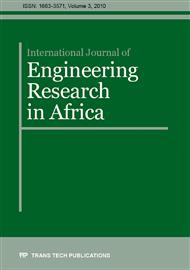[1]
G.J. Foshini and M.J. Gans, On limits of wireless communications in a fading environment when using multiple antennas, Wireless Personal Commun. 6 (no. 3) (1998) 311-335.
Google Scholar
[2]
I.E. Telatar, Capacity of multi-antenna Gaussian channel, Eur. Trans. Telecommun. 10 (1995) 585 – 595.
DOI: 10.1002/ett.4460100604
Google Scholar
[3]
P. Kyristi, D.C. cox,R.A. Valenzuela, and P.W. Wolniansky, Effect of antenna polarization on the capacity of a multichannel element system in an indoor environment, IEEE J. Sel. Areas Commun. 20(6) (2002) 1227- 1239.
DOI: 10.1109/jsac.2002.801225
Google Scholar
[4]
X. Zhao, S. Geng.L., Vuoko,J. Kivinen, and P. Vainikainen, Polarization behaviors at 2. 5 and 60GHz for indoor mobile communications, Wireless Personal Commun. 27 (2) (2003) 99 -115.
DOI: 10.1023/b:wire.0000003825.20103.5f
Google Scholar
[5]
J. M Molina-Garcia-Pardo, J. -V, Rodriguez, and L. Juan –Llacer, MIMO channel sounder based on two network analyzers, IEEE Trans. Instrum. 59 (9) (2008) 2052 – (2058).
DOI: 10.1109/tim.2008.922091
Google Scholar
[6]
J. M Molina-Garcia-Pardo, J. -V, Rodriguez, and L. Juan –Llacer, Line-of-Sight MIMO indoor measurements at 2. 4GHz, Microwave and Optical Technological Letters. 48 (7) (2006) 1403-1405.
DOI: 10.1002/mop.21656
Google Scholar
[7]
J. M Molina-Garcia-Pardo, J. -V, Rodriguez, and L. Juan –Llacer, Polarized indoor MIMO channel measurements at 2. 45 GHz, IEEE Trans. Antennas and Propagation 56 (12) (2008) 3818 – 3828.
DOI: 10.1109/tap.2008.2005542
Google Scholar
[8]
Z. Tang and A.M. Sanagavarapu, Impact of clustering in indoor MIMO propagation using a hybrid channel model, Eurasip Journal on Applied Signal Processing, 11(3) (2005) 1698 -1711.
DOI: 10.1155/asp.2005.1698
Google Scholar
[9]
A. Panahandeh, F. Quitin, J.M. Dricot, F. Horlin, C. Oestges and P. de Doncker, Multi- polarized channel statistics for outdoor-to-indoor and indoor –to-indoor channels, Belgium National Fund for Scientific Research (FRS-FNRS) COST 2100. 12(4) (2005).
DOI: 10.1109/vetecs.2010.5494107
Google Scholar
[10]
C.R. Kothari, Research Methodology, Methods and Techniques, Second Edition, New Age International (P) Ltd. Publishers. (2004).
Google Scholar
[11]
A. F Siegel and C. J Morgan, Statistics and Data Analysis, Second Edition, New York, Wiley Publishers (1996).
Google Scholar
[12]
J. Neter., J. Kutner, C.J., Nachtsheim, and W. Wasserman, Applied linear regression models, Third Edition, Chicago Irwin Publishers (1996).
Google Scholar
[13]
H. Xu, M.J. Gans, D. Chizhik, J. Ling, P.W. Wolniasky and R.A. Valenzuela, Spatial and temporal variations of MIMO channels and impacts on capacity, IEEE Commun. Lett. 3 (6) (1999) 175 – 176.
DOI: 10.1109/icc.2002.996857
Google Scholar


